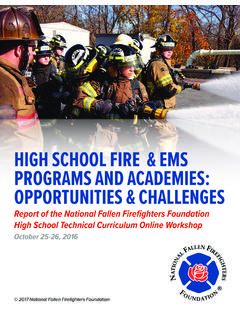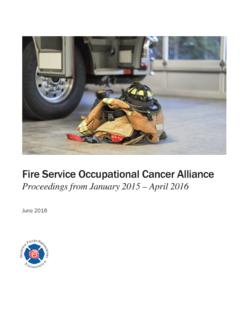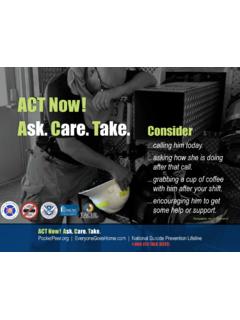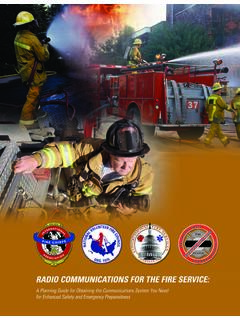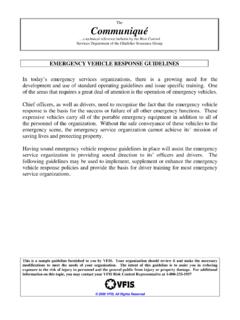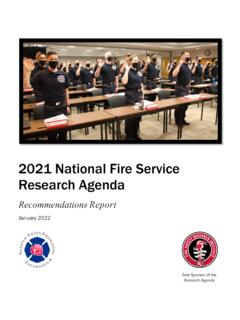Transcription of Fire Service Behavioral Health Management Guide
1 Fire Service Behavioral Health Management Guide Clinical Support Peer Support Firefighters Leadership . cover photography by John M. Buckman III. Contents Introduction.. 1. Behavioral Health Background.. 2. Behavioral Health and the Fire .. 3. How Stress Affects the Body.. 4. The National Fallen Firefighters Foundation's Role.. 4. Using the Behavioral Health Management Guide .. 5. NFFF .. 7. Component One: Leadership.. 11. Leadership's Role.. 11. Leadership Resources.. 13. Component Two: Firefighters.. 15. Firefighters' Role.. 15. Firefighter .. 17. Component Three: Peer .. 19. Peer Support's Role.
2 19. Peer Support Resources.. 20. Component Four: Clinical Support.. 23. Clinical Support's .. 23. Clinical Support Resources.. 25. Glossary.. 27. If you or someone you know Appendix A: 16 Firefighter Life Safety Initiatives.. 28. needs immediate support, Appendix B: Behavioral Health Management Guide please call the National Workshop Attendees.. 29. Suicide Prevention Lifeline at Appendix C: Resource Directory.. 30. 1-800-273-TALK (8255) NFFF.. 30. Other .. 31. Guide note : The term therapist is used in this Guide and could be interchangeable with counselor, clinician, Behavioral Health provider or anyone else who is trained and certified or licensed as a professional provider of Behavioral Health services.
3 Licensed therapists are trained to diagnose and treat symptoms of Behavioral Health disorders using evidence-based practices (EBPs) such as cognitive Behavioral therapy (CBT), Dialectical Behavioral therapy (DBT), Trauma-Focused cognitive Behavioral therapy (TF-CBT), Eye Movement Desensitization and Reprocessing (EMDR), and Prolonged Exposure (PE). See the glossary for more information on these treatments. National Fallen Firefighters Foundation 2017. Introduction Behavioral Health refers to mental/emotional well-being and/or actions that affect wellness. Behavioral Health problems include substance use disorders; alcohol and drug addiction; and serious psychological distress, suicide, and mental disorders.
4 Behavioral Health is often considered synonymous with mental Health , but is the preferred term as it is more positive, inclusive and non-judgmental. There are many questions surrounding the complexity of building and maintaining a fire Service Behavioral Health Management program. Where do we begin to build a program that offers support to our organization's members? How do we find good partners through Employee Assistance Programs and community Health departments? What are the unique needs of firefighters and how do we meet them? How do we help to decrease the stigma related to Behavioral Health ?
5 What if my department doesn't have a formalized program and I need to seek help? These questions come from firefighters, company officers, chief officers, fire chiefs, government agencies, and family members. The questions underscore the complexity of Behavioral Health issues. The fire Service isn't alone on this issue law enforcement, EMS, the military, and the public all face similar questions about the availability and strength of Behavioral Health Management programs. Behavioral Health Management programs are staffed by licensed mental Health and addiction professionals who deliver evidence-based treatment designed to promote well-being by preventing or intervening in Behavioral Health conditions such as depression, anxiety, trauma-related symptoms and addictions.
6 The complexity of Behavioral Health programs can create a sense of paralysis as organizations try to address a myriad of challenges. This Guide seeks to help fire departments in the process by providing guidance and considerations culled from the experience of fire departments across the country. The Guide pulls from the experiences of departments of all sizes, response needs, and demographics. It is not an A-Z Guide for setting up an effective Behavioral Health program, but is designed to help departments understand where to start and what considerations need to be addressed through the lens of an individual department's situation.
7 Funding for the Behavioral Health Management Guide was generously provided through DHS/FEMA's Grant Program Directorate for Assistance to Firefighters Grant Program Fire Prevention and Safety Grants. 1. Behavioral Health Background Historically, mainstream medical practitioners have ignored mental Health disorders, with little education available to the public on these topics. Often, only when something went terribly wrong with someone living with a mental Health issue did people stand up and take notice. Long-standing stigma though lack of education, fear, and misunderstanding has demonized those struggling with mental Health issues.
8 The stigma has strengthened over time, creating challenges at all levels, from those needing treatments to those who set policy on care. Finally, people are being encouraged to seek treatment for mental Health and addiction issues rather than unsuccessfully ignoring or hiding them. Finally, our society has realized that the head is indeed a part of the body, and healthy means healthy from head to toe. Behavioral Health should be looked at on par with physical Health . If left untreated, conditions such as depression, post-traumatic stress, and anxiety are no less debilitating than diabetes, hypertension, or heart disease.
9 Depression is the number one medical reason for loss of productivity in the United States, costing between $51 and $83 billion annually. The good news is that these mental Health conditions can be successfully treated with evidence-based care provided by skilled professionals. Since the fire Service has only recently begun to collect data on Behavioral Health issues, an important starting point is to look at the available data collected on the general public. The National Alliance on Mental Illness (NAMI) cites the following statistics related to Behavioral Health for the public: Approximately 1 in 5 adults experiences mental illness per year.
10 Approximately 1 in 25 adults experiences a serious mental illness per year (interfering with or limiting one or more major life activities). 2. Approximately of adults experience an anxiety Behavioral Health and order (posttraumatic stress disorder, obsessive- thE Fire Service compulsive disorder and/or phobias). Firefighters encounter situations the public rarely, if Approximately 50% of adults experiencing a ever, must face. These experiences go beyond the basic substance use disorder are also living with a mental Behavioral Health risk factors most people face. illness. Firefighters: The third most common cause of hospitalization in America for adults aged 18-44 is a mood disorder Are exposed to potentially traumatic events at a ( , major depression, bipolar disorder).

